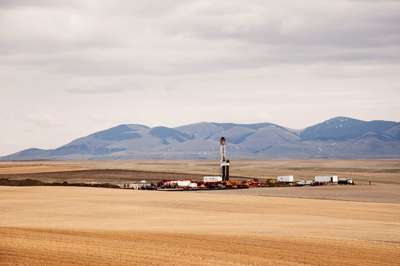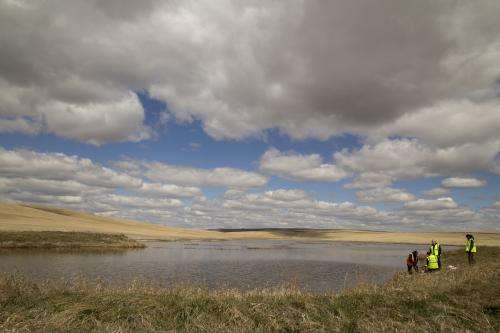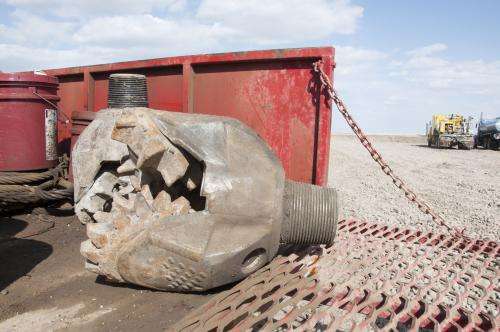Wells in northern Montana mark big step for carbon sequestration research

(Phys.org) —An effort to study how to safely store carbon dioxide deep underground took a major step forward this spring when Montana State University researchers successfully drilled a pair of wells in northern Montana.
After more than two years of careful preparation and study of the geology in the Kevin Dome (pronounced KEE-vin) area of Toole County, researchers with the MSU-led Big Sky Carbon Sequestration Partnership have drilled two wells. The wells will be used to test the underlying sedimentary formation's ability to store carbon dioxide, a greenhouse gas. In the drilling process, researchers also removed 450 feet of rock core that will aid in their study.
"It's an exciting time for the project. The data collected from these wells will contribute to the international research effort on carbon sequestration," said Lee Spangler, who is BSCSP director, as well as associate professor of chemistry and associate vice president of research and economic development at MSU.
The Kevin Dome Large Scale Carbon Storage Project, which is funded through an award from the U.S. Department of Energy, is an eight-year project being run through the BSCSP. It is one of seven national partnerships involved in DOE's Regional Carbon Sequestration Partnership Program. Relying on state-of-the-art technologies from engineering, geology, chemistry, biology, geographic information systems and economics, BSCSP is seeking to develop novel approaches for carbon storage in a region that encompasses Montana, Wyoming, Idaho, South Dakota, eastern Washington and Oregon.
Spangler said Kevin Dome, which lies like an inverted bowl beneath the rolling surface of the Northern Plains, has the potential for large-scale carbon sequestration because the 700-square-mile geologic feature has already been holding carbon dioxide for 50 million years. The naturally occurring carbon dioxide is contained in a deep porous rock layer, which occurs below a dense layer of rock that acts as a cap, collectively known as the Duperow formation.
Because it is the best practical source for testing the area's suitability for carbon sequestration, the group plans to extract one million metric tons of carbon dioxide now stored in Kevin Dome, bring it up some 4,000 feet through the first of the two recently completed wells, transport it six miles via pipeline and inject it into the flank of the Duperow formation where carbon dioxide does not occur. The second well, which was drilled this week to a depth of almost 5,000 feet, will be used to monitor the carbon dioxide and subsurface geochemistry near the yet-to-be-drilled injection well.

Spangler said the infrastructure now in place is a major step toward producing data showing whether or not the area's geologic structure can provide a safe and viable site to store carbon dioxide, offering a potential path toward cleaner energy. In the future the project's baseline data on Kevin Dome geology, as well as information showing how the carbon dioxide behaves underground, will be critical for moving the technology towards commercial application.
Scientists will closely monitor the site's geology, geochemistry, water quality, air quality and the underground behavior of the carbon dioxide as the project continues.
"There is significant interest in the technologies we are using and the science we are exploring on this project," Spangler said. "We are collaborating with universities, researchers and private companies from Montana and around the country. All of us are anxiously awaiting the forthcoming data and results so we can apply it to our energy research throughout the Big Sky region and beyond."

The drilling of the two wells, which required about two week each, also included a process of removing rock cores.
The cores taken from the two wells reveal the area's deeply buried geology and will offer project scientists samples to test the properties of the rock. With one set of cores coming from a well where the porous rock layers were subjected to the presence of carbon dioxide, and the other from an area without carbon dioxide, researchers will be able to compare the chemical changes induced by the presence of the gas.
The cores will also provide an invaluable teaching and research tool for geology faculty and students, Spangler said. The entire set of cores will be permanently stored at MSU.
Because understanding the geology of Kevin Dome is key to project's success, researchers began conducting an extensive seismic survey of the area before any wells were drilled. In addition to ensuring that the area is suitable for carbon dioxide injection, the seismic data is being used in geologic modeling efforts and can produce detailed three-dimensional images of the subsurface.
To highlight the science behind the seismic survey, Kathy Kasic, instructor of film at MSU's School of Film and Photography, produced a short educational film, entitled "What's Shaking on Kevin Dome?"
Spangler, who is also director of the Zero Emissions Research and Technology Center (ZERT) and the Energy Research Institute (ERI), said MSU's energy research program is poised as a global leader in the search for innovative energy solutions.
"MSU is actively investigating many aspects of alternative energy research," Spangler said. "ERI is also doing cutting-edge studies involving biofuels, wind and fuel cells – all part of MSU's overall effort to support the development of a wide range of viable energy solutions for the future."
Provided by Montana State University
















